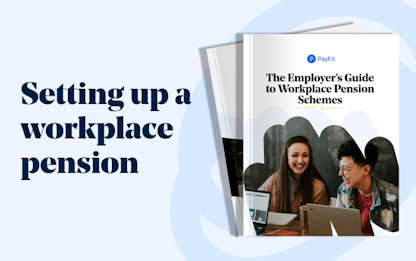- Blog
- |People management
- >Pensions
- >employee-pension-scheme-guide
Workplace Pension Schemes - What Do Employers Need to Know?


It's not uncommon for employees to worry about their future and wonder what workplace pension schemes you offer as an employer.
However, as an employer, you might not know the first thing about workplace pensions or why you must offer them to employees.
This article will discuss UK workplace pensions and why it's crucial to know about them. We'll also talk about how to set these up properly.
What is a pension?
A pension is a retirement fund set up for an employee by their employer, the employee, or both parties.
In most cases, employees cover the largest share of contributions to this fund (employees cover 5%, whereas the employer only covers 3%).
The goal of a pension is to help employees have something they can live off later in the future after retirement or when they want to start working less.
There are three main types of pension schemes: personal, workplace, and state.
A personal pension scheme is often set up by people who are self-employed or ineligible to join a workplace pension scheme, for example, freelancers or solopreneurs.
The State Pension is received from the Government when individuals reach the State Pension age — which is still 66 as of 2022 but soon expected to increase to 68.
Considering that the UK State Pension is only £185.15 per week, most employees would want to know if you have a workplace pension scheme to help them save towards eventual retirement effectively.
As an employer, you need to know what is required of you to successfully set up a workplace pension scheme.
What is a workplace pension scheme?
A workplace pension scheme is a pension set up by you, the employer, to help employees save for their future and live after work.
"Works," "occupational," work-based," or "company" pensions are some of the other names a workplace pension is sometimes called — however, they all mean the same thing.
The workplace pension scheme came to life after the UK government realised too many citizens were relying solely on the State Pension — which was usually not enough. So in 2012, the UK government passed a law that obligated employers to enrol eligible employees into a workplace pension scheme automatically.
Before we discuss what automatic enrolment is and who you can consider an eligible employee, let's consider the main types of workplace pension schemes.
Types of workplace pension schemes
The two main types of workplace pension schemes in the UK are:
Defined benefit pensions
Defined contribution pensions
Defined benefit pensions
A defined benefit pension or final salary scheme is one where an employee's pension depends on their salary and how long they've been part of the scheme.
So as an employee's pay increases over time, so will the employer pension contributions towards their retirement fund.
Depending on the pension provider you choose for the pension scheme, you can make your employees' overtime and bonuses count towards their pension.
For this scheme, you and your employee need to contribute to the fund.
Defined contribution pensions
A defined contribution pension is also known as a money purchase pension scheme. For this type of scheme, any contribution you make will be invested in stocks, bonds, and other investment options to be given to the employees when they retire.
The amount paid out to employees at the end of the day depends on the investment returns.
One significant factor that differentiates the defined contribution scheme from defined benefits is that the former depends on how much has actually been paid into the scheme and not how long an employee has been in the scheme.
Just as there are different types of pension schemes, so too are there different methods you can use to make contributions to your employees' pension pot.
Three of the methods are:
Salary sacrifice: Employees give up part of their gross salary, and the employer pays this straight into their pension. In most cases (and the main reason salary sacrifice is so popular), the employee pays less tax while both the employee and employer pay less National Insurance.
While employers enjoy National Insurance savings with salary sacrifice, there are some cons to consider, including:
Varying the employee's contracts (which the employee needs to agree to) where the employee essentially has a lower salary.
Implications on employees who may earn close to national minimum wage as salary sacrifice can reduce the earnings below national minimum wage (this is actually illegal).
Impact on things such as an employee's entitlement to statutory parental or sick pay or an application for a mortgage (as employee earnings look lower).
Net Pay Arrangement: You deduct your employees' pension contribution from their gross pay before tax.
Relief At Source: This is quite the opposite of the net pay pension contribution. In this situation, the pension contribution is calculated on the employee's gross pay, then reduced by 20% and deducted after tax. The tax relief is reclaimed by the pension provider, from HMRC, which is then added to the employee's pension pot directly.
Let's now consider who you can enrol into your workplace pension schemes.
What is auto-enrolment, and how does it work?
Auto-enrolment means employers must automatically enrol all employees or workers into a workplace pension scheme if these employees meet certain specific criteria.
Employees should be auto-enrolled if they:
are at least 22 years old
work or usually work in the UK
have not yet reached State Pension age
earn more than £9,440 a year
Are part of a qualifying scheme not already in a workplace pension scheme which meets certain government standards.
Although you're obligated to enrol employees who meet these criteria, employees can still opt out of your scheme if they want to — however you'll have to enrol them first.
Some employers think they don't even need to set up a pension scheme as they can just ask their employees to opt out before they're added to a scheme. However, employees can only choose to opt out once they have been successfully enrolled into a pension scheme, which includes notifying the pension provider that the employee has joined the scheme, and in most cases, the pension contributions have been paid to the pension provider.
Some providers will allow clients to withhold payment for employees who are in their first month so that if the employee does opt out, the client still has those funds available to provide the refund. Not very many schemes offer this, though.
All eligible workers must contribute at least 8% of their earnings to their pension pot. With a workplace pension scheme, you're expected to pay at least 3% of the contribution — leaving your employee (aided with governmental tax relief) to make up the rest.
How to set up a workplace pension scheme
Here's a simple 4-step process for setting up an occupational pension scheme.
Step 1: Find out your staging start date
The staging date or duties start date is when your auto-enrolment obligations are expected to start. This start date is usually your first employee's first day of employment.
You're expected, as an employer, to set up your workplace pension scheme no later than six weeks after your staging date. Failure to set up the pension scheme within this time frame would incite enforcement action from The Pensions Regulator (TPR).
Step 2: Choose your pension scheme
Once you know your duties start date, you'll need to choose a pension scheme.
No matter the scheme you choose, ensure it allows for auto-enrolment. Before selecting a scheme, some of the factors to consider are whether:
it will accept all your eligible staff
the costs are reasonable
it will work with your payroll and so on
TPR offers more resources on what to look out for in a pension scheme.
Step 3: Identify employees who are eligible for your pension scheme
Employees usually fall into one of three categories regarding pension scheme eligibility.
Type 1 employees are the ones who are between 22 and State Pension Age and who earn over £833 a month. You must put all Type 1 employees into a pension scheme.
Type 2 employees, on the other hand, do not meet the age or earning criteria to be enrolled in a pension scheme.
The final category is an Entitled worker, who can ask to join the scheme, but the scheme doesn't need to be a qualifying scheme. Therefore employers don't need to pay the full 3%. Entitled workers are UK employees aged between 16-74, earning under £6240 P/A.
Step 4: Inform your staff of the pension scheme
The next step is to inform your staff whether they'll be automatically enrolled in your pension scheme or not.
By so doing, you afford eligible employees the time to decide whether to opt out, where they want to invest their funds, and so on.
You must individually inform your employees of how the automatic enrolment applies to them within six weeks after your staging date.
Step 5: Declare your compliance
The final step toward setting up a workplace pension scheme involves completing an online declaration of compliance. To complete this declaration of compliance, you need to receive a letter code and PAYE reference from TPR.
However, your duties do not end with the declaration.
You need to continue accessing your employees monthly. With a tool like Payfit, accessing employee status month-by-month until they become eligible, you don't have to expend too much time and energy or make any errors.
For instance, you'll receive a warning message in your payroll whenever an employee needs to be enrolled. Without actioning the enrollment, you'll be unable to process payroll.
PayFit's assessment checks for any new starters who might be eligible, or employees who weren't previously eligible, who then become eligible, for example, they've just turned 22, or their earnings have increased.
You'll also need to re-declare your compliance with The Pensions Regulator every three years — but you can choose a date (a re-enrolment date) within the three months before and after the three-year anniversary.
How can PayFit help when it comes to workplace pension schemes?
PayFit offers a pain-free and efficient way for you to handle your pensions. As such, you'll never have to worry about auto-enrolment and other compliance issues.
Ready to talk about your workplace pensions? Book a demo with one of our product specialists today to learn how Payfit can meet your specific business needs.


The 2024 UK National Living Wage - An Employer’s Guide

The Cost Of Recruitment In The UK - What You Might Not Know

UK National Insurance Changes for January 2024

End Of Tax Year 2023/2024 - Eight Key Changes For 24/25

Strategies to Reduce Employee Turnover

